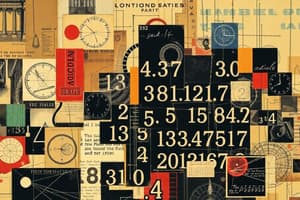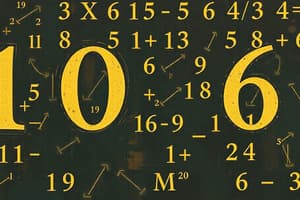Podcast
Questions and Answers
What is the primary purpose of differentiation in calculus?
What is the primary purpose of differentiation in calculus?
- To analyze the relationships between angles and sides of triangles
- To calculate the instantaneous rate of change of a function (correct)
- To determine the total change over an interval
- To compute a function's domain and range
In trigonometry, what is the sine of an angle defined as in a right-angled triangle?
In trigonometry, what is the sine of an angle defined as in a right-angled triangle?
- The length of the adjacent side divided by the hypotenuse
- The length of the opposite side divided by the adjacent side
- The length of the hypotenuse divided by the opposite side
- The length of the opposite side divided by the hypotenuse (correct)
Which statement correctly describes the relationship between domain and range in functions?
Which statement correctly describes the relationship between domain and range in functions?
- The range consists of the possible input values of a function
- The domain and range are always equal in value
- The domain consists of the possible output values of a function
- The domain defines the possible input values, while the range defines the possible output values (correct)
What is the primary focus of probability in relation to statistics?
What is the primary focus of probability in relation to statistics?
Which of the following best describes exponential functions?
Which of the following best describes exponential functions?
What is the correct interpretation of the expression x + 3 = 8 when solving for x?
What is the correct interpretation of the expression x + 3 = 8 when solving for x?
Which of the following statements is true about rational and irrational numbers?
Which of the following statements is true about rational and irrational numbers?
How does the order of operations influence the evaluation of mathematical expressions?
How does the order of operations influence the evaluation of mathematical expressions?
Which equation represents a linear function and why?
Which equation represents a linear function and why?
What property does the Pythagorean Theorem describe?
What property does the Pythagorean Theorem describe?
Flashcards
Domain of a Function
Domain of a Function
The set of all possible input values for a function.
Range of a Function
Range of a Function
The set of all possible output values for a function.
Sine (sin)
Sine (sin)
A trigonometric function that relates the angle of a right triangle to the ratio of its opposite side to its hypotenuse.
Differentiation
Differentiation
Signup and view all the flashcards
Integration
Integration
Signup and view all the flashcards
What is addition?
What is addition?
Signup and view all the flashcards
What is a rational number?
What is a rational number?
Signup and view all the flashcards
What is an equation?
What is an equation?
Signup and view all the flashcards
Define perimeter.
Define perimeter.
Signup and view all the flashcards
What is a function?
What is a function?
Signup and view all the flashcards
Study Notes
Basic Arithmetic Operations
- Addition combines two or more numbers to find their total. Example: 2 + 3 = 5.
- Subtraction finds the difference between two numbers. Example: 5 - 2 = 3.
- Multiplication is repeated addition. Example: 3 x 4 = 12 (3 added 4 times).
- Division separates a number into equal groups. Example: 12 ÷ 3 = 4 (12 divided into 3 equal groups).
- Order of operations (PEMDAS/BODMAS) dictates the sequence for evaluating expressions: Parentheses/Brackets, Exponents/Orders, Multiplication and Division (left to right), Addition and Subtraction (left to right).
Number Systems
- Natural numbers (counting numbers): 1, 2, 3,...
- Whole numbers: 0, 1, 2, 3,... (includes zero)
- Integers: ..., -3, -2, -1, 0, 1, 2, 3,... (includes negative whole numbers)
- Rational numbers: numbers expressed as p/q, where p and q are integers and q ≠ 0. Examples: 1/2, 3, -2/5.
- Irrational numbers: numbers not expressible as a fraction of two integers. Examples: π, √2.
- Real numbers: all rational and irrational numbers.
Algebra
- Variables represent unknown quantities. Example: In x + 2 = 5, 'x' is a variable.
- Equations state that two expressions are equal. Example: x + 2 = 5.
- Inequalities show a relationship of greater than or less than. Example: x > 2 or x < 5.
- Solving equations involves isolating the variable to find its value.
- Linear equations represent a straight line on a graph. Common form: y = mx + b.
- Polynomials are expressions with variables and coefficients. Example: 2x² + 3x - 1.
Geometry
- Points in a two-dimensional space are defined by their x and y coordinates.
- Shapes in a two-dimensional space, like triangles, rectangles, and circles, have properties concerning sides, angles, and areas.
- Three-dimensional shapes, like cubes and spheres, have properties such as volume, surface area, and their dimensions.
- The Pythagorean Theorem relates the sides of a right-angled triangle: a² + b² = c².
Data Analysis
- Data collection, organization, and analysis are key mathematical aspects.
- Data visualization (charts and graphs) helps interpret data concisely.
- Statistics involves collecting, organizing, analyzing, and interpreting data. Mean, median, mode, and range are common statistical measures.
Functions
- A function maps inputs to outputs. Each input has exactly one output.
- Functions are often represented with equations or graphs.
- Common functions include linear, quadratic, and exponential functions.
- Understanding domain (possible inputs) and range (possible outputs) is crucial for analyzing functions.
Trigonometry
- Trigonometry deals with relationships between angles and sides of triangles, especially right-angled triangles.
- Trigonometric ratios (sine, cosine, tangent) relate angles to ratios of sides.
- Trigonometry has applications in fields such as engineering and physics.
Calculus
- Calculus deals with continuous change.
- Differentiation calculates a function's instantaneous rate of change.
- Integration calculates the accumulation of change over an interval.
Probability and Statistics
- Probability determines the likelihood of events.
- Statistics involves collecting, organizing, and interpreting data.
- Probability and statistics are used for prediction and inference.
Studying That Suits You
Use AI to generate personalized quizzes and flashcards to suit your learning preferences.




